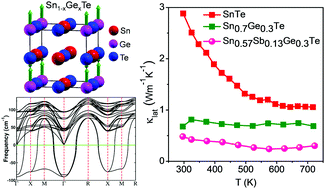当前位置:
X-MOL 学术
›
Energy Environ. Sci.
›
论文详情
Our official English website, www.x-mol.net, welcomes your
feedback! (Note: you will need to create a separate account there.)
Engineering ferroelectric instability to achieve ultralow thermal conductivity and high thermoelectric performance in Sn1−xGexTe†‡
Energy & Environmental Science ( IF 32.4 ) Pub Date : 2019-01-04 00:00:00 , DOI: 10.1039/c8ee03162b Ananya Banik 1, 2, 3, 4, 5 , Tanmoy Ghosh 1, 2, 3, 4, 5 , Raagya Arora 2, 4, 5, 6 , Moinak Dutta 1, 2, 3, 4, 5 , Juhi Pandey 5, 7, 8, 9 , Somnath Acharya 5, 7, 8, 9 , Ajay Soni 5, 7, 8, 9 , Umesh V. Waghmare 2, 4, 5, 6, 10 , Kanishka Biswas 1, 2, 3, 4, 5
Energy & Environmental Science ( IF 32.4 ) Pub Date : 2019-01-04 00:00:00 , DOI: 10.1039/c8ee03162b Ananya Banik 1, 2, 3, 4, 5 , Tanmoy Ghosh 1, 2, 3, 4, 5 , Raagya Arora 2, 4, 5, 6 , Moinak Dutta 1, 2, 3, 4, 5 , Juhi Pandey 5, 7, 8, 9 , Somnath Acharya 5, 7, 8, 9 , Ajay Soni 5, 7, 8, 9 , Umesh V. Waghmare 2, 4, 5, 6, 10 , Kanishka Biswas 1, 2, 3, 4, 5
Affiliation

|
High thermoelectric performance of a crystalline solid requires it to have low thermal conductivity which is one of the utmost material challenges. Herein, we demonstrate how the local structural distortions and the associated ferroelectric lattice instability induced soft polar phonons effectively scatter the heat carrying acoustic phonons and help achieve ultralow lattice thermal conductivity in SnTe by engineering the instability near room temperature via Ge (x = 0–30 mol%) alloying. While Sn1−xGexTe possesses a global cubic structure above room temperature (x < 0.5), by analysing synchrotron X-ray pair distribution functions (PDFs) we showed that local rhombohedral distortion exists which is sustained up to the studied maximum temperature (∼600 K) above the ferroelectric transition (TC = 290 K). We showed that the local rhombohedral distortions in global cubic Sn1−xGexTe are predominantly associated with local Ge off-centering which forms a short-range chain-like structure and scatters acoustic phonons, resulting in an ultralow lattice thermal conductivity of ∼0.67 W m−1 K−1. In addition, Sb doping in Sn1−xGexTe enhances the Seebeck coefficient due to p-type carrier optimization and valence band convergence, which leads to a synergistic boost in the thermoelectric figure of merit, zT, to ∼1.6 at 721 K. The concept of engineering ferroelectric instability to achieve ultralow thermal conductivity is applicable to other crystalline solids, which opens up a general opportunity to enhance the thermoelectric performance.
中文翻译:

工程铁电体的不稳定性,可在Sn 1- x Ge x Te † ‡中实现超低热导率和高热电性能
结晶固体的高热电性能要求其具有低导热率,这是最大的材料挑战之一。在这里,我们演示了局部结构变形和相关的铁电晶格不稳定性诱发的软极性声子如何有效地散射载热声子,并通过在室温下通过Ge(x = 0-30摩尔%)合金化。Sn 1- x Ge x Te在室温以上具有整体立方结构(x<0.5),通过分析同步加速器X射线对分布函数(PDF),我们发现存在局部菱面体形变,这种形变一直持续到铁电跃迁以上所研究的最高温度(〜600 K)(T C = 290 K)。我们发现整体立方Sn 1- x Ge x Te中的局部菱面体畸变主要与局部Ge偏心有关,后者形成了短程链状结构并散射了声子,从而导致了超低的晶格热导率0.67 W m -1 K -1。另外,Sn 1- x Ge x中的Sb掺杂TE提高塞贝克系数由于p型载流子的优化和价带收敛,导致在的优点,的热电的协同推动,这样的zT,到~1.6在721 K.工程铁电不稳定的概念来实现超低热传导率它适用于其他结晶固体,这为提高热电性能开辟了一般机会。
更新日期:2019-01-04
中文翻译:

工程铁电体的不稳定性,可在Sn 1- x Ge x Te † ‡中实现超低热导率和高热电性能
结晶固体的高热电性能要求其具有低导热率,这是最大的材料挑战之一。在这里,我们演示了局部结构变形和相关的铁电晶格不稳定性诱发的软极性声子如何有效地散射载热声子,并通过在室温下通过Ge(x = 0-30摩尔%)合金化。Sn 1- x Ge x Te在室温以上具有整体立方结构(x<0.5),通过分析同步加速器X射线对分布函数(PDF),我们发现存在局部菱面体形变,这种形变一直持续到铁电跃迁以上所研究的最高温度(〜600 K)(T C = 290 K)。我们发现整体立方Sn 1- x Ge x Te中的局部菱面体畸变主要与局部Ge偏心有关,后者形成了短程链状结构并散射了声子,从而导致了超低的晶格热导率0.67 W m -1 K -1。另外,Sn 1- x Ge x中的Sb掺杂TE提高塞贝克系数由于p型载流子的优化和价带收敛,导致在的优点,的热电的协同推动,这样的zT,到~1.6在721 K.工程铁电不稳定的概念来实现超低热传导率它适用于其他结晶固体,这为提高热电性能开辟了一般机会。











































 京公网安备 11010802027423号
京公网安备 11010802027423号